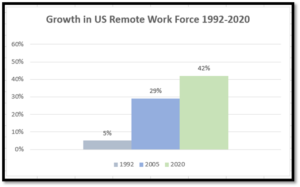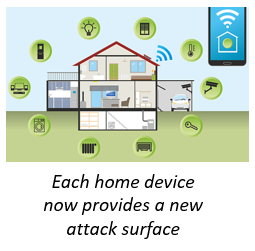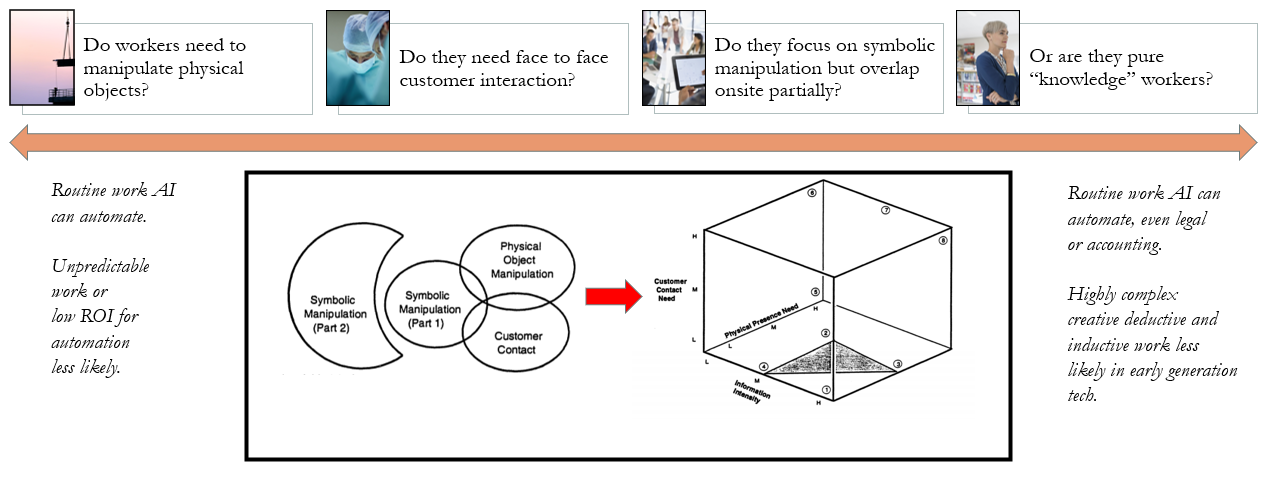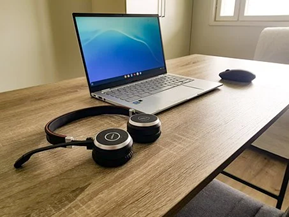Safe and Snug in My Remote Office, Or Am I?
Introduction
March 2020 was scary for most people around the world. A new and dangerous virus was afoot and uncertainty was the order of the day. As it turned out, for many of us we made a rapid pivot to working remotely and to social distancing. In this post I will examine the origins of remote work, how it played out for the broader US workforce, and just how safe all those happy knowledge workers really are riding on waves of light from their home offices given the dangers of the Cybersecurity shoals all around them. I will also touch on the key question of what kind of work might remain remote and finish up with a nod to Henry George by taking a look at the inequities these arrangements have created.
Remote Work: The Beginnings
The first model of remote work is provided to us in the fossil record. In Figure 1, we see the 4-million-year-old footprints of a female Australopithecus Afarenis in Tanzania and her child. Our ancestors were hunter gatherers who worked both at home and outside the cave. Wherever they needed to work, they simply walked there. We also see that from the beginning, remote work also came with childcare responsibilities.

Figure – Human powered remote work circa 4M years ago
Many cultures later developed “cottage industries” as the precursors to modern work-at-home formats. Jumping ahead a bit in time, Nilles coined the term Telecommuting in 1974 to rationalize commuting patterns and air pollution. At a time when few people had seen a computer except perhaps on Star Trek, Nilles wrote “…work performed using computer and communications technology outside the normal confines of space and time” would reduce traffic and, as a result, pollution in California. Such thinking, coupled with advances in technology, later enabled broad trends in outsourcing and offshoring especially in IT in the 1990s and beyond.
Remote Work: Where Are We Today
Remote work did not spring up overnight due to the COVID-19 pandemic. In fact, remote system access, while slow, had been a standard communications capability beginning in the 1920s and maturing with standard modems in the 1950s and 1960s. With faster dialup speeds the first effective remote work setups began arriving about 30 years ago. I recall having fulltime work from home engineers located in other States on my team as early as 1995.
 As a result, as can be seen in Figure 2, remote work levels had been steadily climbing in the US. Going into the pandemic we were approaching roughly 30% of the entire workforce on a remote footing and growing at a rapid 44% per year. When lockdown orders were issued in early 2020, companies organized to allow large blocks of staff to begin working from home consistently. This led to about a 42% level of remote work as of the 3rd Quarter 2020. A full 26% of staff continued working on premises including essential and service workers and roughly 33% were not working due to lockdowns or recession impacts. These figures naturally fluctuate constantly.
As a result, as can be seen in Figure 2, remote work levels had been steadily climbing in the US. Going into the pandemic we were approaching roughly 30% of the entire workforce on a remote footing and growing at a rapid 44% per year. When lockdown orders were issued in early 2020, companies organized to allow large blocks of staff to begin working from home consistently. This led to about a 42% level of remote work as of the 3rd Quarter 2020. A full 26% of staff continued working on premises including essential and service workers and roughly 33% were not working due to lockdowns or recession impacts. These figures naturally fluctuate constantly.
Employees enjoy the flexible schedules provided by remote work arrangements and report being happier and more productive. The challenge most people mention is that it is more difficult to separate work and home time due to the physical confluence. For businesses, the results are still not fully quantified and they will need to consider a variety of factors including productivity, hiring, training, sales, support, and even real estate costs. For our society, morphing into a permanent configuration of having nearly half the work force at home will have significant social, technical, and economic impacts not yet fully explored.
Cybersecurity: Your Home as a Castle Keep
Amidst all of this one thing you might want to consider if you are one of the “remotes” is the security of your home office and in particular your home computing environment. The cyber threat landscape has evolved quickly with the COVID-19 pandemic, introducing shifting attack types of quick tempo and significant impact. There has been a sharp increase in malicious activity taking advantage of nations and organizations at their most vulnerable. Attackers are always attracted to “soft targets” when sophisticated players are defending themselves well. You may feel safe in your den in the suburbs, but a cybercriminal can be in and out of your window with your laptop in minutes. Social Engineers can also prey on unsuspecting residential office dwellers who are less equipped for security screening than when in a formal office setting.
 There are a few basic things the experts recommend considering in this new normal of remote work where cyber criminals lurk around every web page:
There are a few basic things the experts recommend considering in this new normal of remote work where cyber criminals lurk around every web page:
-
Understand security fundamentals including password complexity with 14-character length, apply patches, enable HTTPS everywhere within home browsers, encrypt all data at rest, avoid phishing attempts, and practice online distancing.
-
With the advent of IoT home technologies like smart speakers (Sonos One, Amazon Echo, Google Nest, or HomePod) there are new “attack vectors” in your home. Move these devices out of your work area, protect them with a strong password, and lock down privacy settings.
-
Also, data needs to be backed up. This can be to the cloud, local drives, or both. Backups should always be encrypted and protected.
-
Ensure your Wi-Fi is encrypted with Wi-Fi Protective Access 2 (WPA2), disable remote administration on your router, and change any default passwords. Change home Wi-Fi passwords annually.
-
 To up your protection, consider using a physical Ethernet cable instead of Wi-Fi where possible.
To up your protection, consider using a physical Ethernet cable instead of Wi-Fi where possible.
Remote Work Impacts
When we assess remote work in the aggregate what are we left with? The primary conclusion is that remote work is here to stay. While we cannot say if remote work will settle at 40% or 50% of the workforce or at some other level, we can be reasonably assured it will not drop back to pre-2000 levels which were already significant. It is also clear that companies will take a variety of approaches to this from allowing limited remote work to embracing full remote work for the entire staff thereby driving aggregate remote working upwards.
Some research has been done around which types of activities are best suited to remote work. As it turns out one of the earliest models was developed by Apte over 25 years ago. Figure 3 provides this model for understanding and plotting which job functions align well with remote work and which align with on-site work or a hybrid version. Essentially, Symbolic Manipulation jobs fit with remote work and Physical Object Manipulation align with on-site work along a continuum. In a recent talk, I proposed to overlay this model with the application of AI technology. Specifically, we might consider which of these domains could see AI accelerate the automation of the work and thereby facilitate further remote relocation of the job functions (or not).

Figure – Remote Work Decision Matrix
Other key trends that will continue to build will be the delinking of talent from location. With remote work human talent can theoretically be sourced from anywhere on the planet. For certain companies this has been true for some time, but new technological, social, and work conditions now make this broadly possible for many industries. This feature of the global talent pool may further drive employment patterns towards transactional engagement models (the “gig” economy) as opposed to long duration commitments. Furthermore, entire corporate processes may need to be reengineered to meet these new patterns of highly decentralized organizations. This includes recruiting, goal setting, teaming, and even managing new security threats in a world where employees may never visit an office. Finally, in the wake of the pandemic, companies will need to broaden their “what-if” analysis boundaries. The improbable scenarios once unconsidered will need to be gamed out.
Remote Work, Innovation, and Inequality
We have covered a lot of ground so far. From our ancestors 4 million years ago to the massive shifts towards remote work in recent years to a look ahead at what might be to come including the technological security aspects of these changes. However, we have skirted around one of the most important social aspects of this broad evolution and it is something on which Henry George the 19th Century Economist, Philosopher, and writer had something to say.
The push towards remote work certainly provides benefits for many in society including our corporations, workers, consumers, communities, and more. Yet, this adoption of remote work has been based on a series of innovations including high-speed Internet, video-conferencing, collaboration tools, personal computers, WiFi, and Double Espresso Lattes. While these technologies have enabled this shift, their adoption has put a strain on traditional parts of society. Transit systems are starved for riders, city center retailers are devoid of walk-ins, and large sectors of the economy have been impacted negatively. At the same time, many citizens have not been able to take advantage of this new remote work phase due to their on-site job responsibilities, unemployment, or lack of access to technology. Unfortunately, the US continues to struggle with itself on how to respond to these changes equitably. As Henry George said in 1884:
“… industrial changes imply social changes and necessitate political changes. Progressive societies outgrow institutions as children outgrow clothes. Social progress always requires greater intelligence in the management of public affairs; but this the more as progress is rapid and change quicker.”
George goes on to explain that innovation, inventions, and discoveries lead to the increase in the production of wealth which does benefit society. However, these benefits are not always equally distributed. George states:
“…benefits are not merely unequally distributed, but they are bringing about absolutely injurious effects. They are concentrating capital, and increasing the power of these concentrations to monopolize and oppress; are rendering the workman more dependent…”
These words written nearly 140 years ago seem like they could be lifted out of any newspaper today reporting on one of the Tech giants who dominate our current economic landscape. I might add to this the fact that we seem to be creating a new style of two-tier economic advantage where those who can work within their protected remote bubbles accrue new types of benefits as compared to those who must labor on-site. Certainly, something to think about in the safety of your remote cyber castle.

References
- Gurche, John, “Australopithecus Afarensis”, thesciences, viewed 10/16/2020.
- Nilles, J., “Telecommunications Substitutes for Urban Transportation”, Center for Futures Research, Graduate School of Business Administration, University of Southern California, Los Angeles, CA, 1974.
- Wong, May, “Stanford research provides a snapshot of a new working-from-home economy”, Stanford News, June 29, 2020.
- Bourgeix, Pierre, “Remote workers present a new security threat in the age of COVID-19”, Security Infowatch.com, May 26th, 2020.
- Apte, Uday M., and Mason, Richard O., “Global Disaggregation of Information-Intensive Services”, Management Science, Vol. 41, No. 7 (Jul., 1995), pp. 1250-1262.
- George, Henry, Social Problems, (1884), Robert Schalkenbach Foundation, New York, 1996.




Leave a Reply
Want to join the discussion?Feel free to contribute!